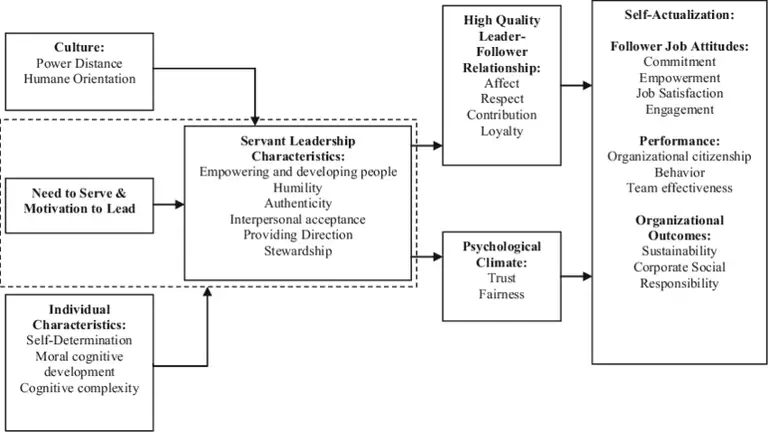There are many ways to lead a company and effective leaders know that leadership can make or break a business. The leadership style influences a lot: the growth of people, the sense of community, employee satisfaction, and so much more. There is one leadership philosophy that has it all in one place: the servant leadership style.
With the servant leadership model, certain attitudes fare better than others when leading a team. If that’s true, it’s no wonder there are so many opinions on how to do so effectively. But who’s to say which is best? Only the individual running the ship. Below is an explanation of just one of a handful of leadership models available, and a unique one at that.
What is the servant leadership model?
Servant leadership became mainstream when Robert K. Greenleaf, founder of the Greenleaf Center for Servant Leadership, who wrote The Servant as Leader, a 1970s essay on the seveant leadership philosophy.
The main components of the servant leadership model are best described on the Greenleaf Center’s official website: “the servant leader shares power, puts the needs of others first, and helps people develop and perform as highly as possible.”

The servant leadership model is expressed through an attitude that focuses on the growth of character and stewardship solely. The overall outcome generates a lower retention rate and fosters higher productivity by making an impact on the lives of the humans behind the machine.
Little did Robert Greenleaf know that his model of transformational leadership would shape the future leaders in workplaces around the world.
Characteristics of the servant leadership philosophy
A majority of servant leadership characteristics encircle the idea of humility, that you are not the most vital cog in the machine. It is both an inherent skill and a developed trait that often goes unappreciated, especially in highly capitalistic societies.
Here is how the philosophy works.
Having a servant heart - the servant leadership style entails that the leader aims to serve and help others and put their needs first.
Listening - one of the principles of the servant leadership approach is that the leader actively listens to others' ideas.
Empathy - in the servant leadership style, the leaders should feel compassion for others and be sensitive to their needs.
Healing - the servant type of leader provides a supportive work environment where employees have room for professional growth and development.
Awareness - this type of leader is aware of the context of their workplace and takes into account all details in their decision-making process. Thanks to their emotional intelligence, they know the strengths and weaknesses of their team.
Persuasion - one of the characteristics of servant leadership is that the leader can easily persuade the rest of their team into taking a certain path and making a decision. They have an unselfish mindset and persuade others with arguments rather than relying on authority.
Conceptualization - as one of the key principles of the servant leadership model, the leader can think beyond everyday tasks and grasp a top-down approach not just to leadership, but also to a business model and everyday operations.
Foresight - the servant leader has massive decision-making power because they can anticipate problems before they happen.
Stewardship - the leader creates a culture of trust by taking responsibility for the team's progress, results and well-being and creates a culture of trust.
Commitment to growth - this style of leadership entails that the leader identifies opportunities for growth in their team and sees them through.
The servant leadership theory
The servant leadership theory revolves around what it believes true leadership should be defined as. A power leader, or traditional leader, is simply the leader by title and not by any demonstrating traits or leadership skills. As a result, there isn’t a need to connect with employees on a personal level or any value placed on the idea of mentorship.
Servant leadership challenges the idea that people who are treated well perform well, applying the phrase “you reap what you sow” to employees who, no matter what industry you’re in, determine output and thus the entire company’s level of value and, on some level, existence.
Jobs that work best with servant leadership
In theory, high positions in all fields of work can function under the servant leadership model - with understandably varying results - but some are more receptive than others. With servant leadership, the following career fields are most complimentary:
Politics: political figures are known as servants of the people. In an ideal government, constituents are able to share their grievances with their local leaders, who will then advocate on their behalf. It is an inherently humble role that relies on the public for what they know they need for their community, rather than enacting harmful policies.
Non-profits: NPOs are in the best positions to create leaders. Those who are working in a non-profit often share the company’s goals anyway, which is a strong incentive to work together as a team and not a hierarchy. Non-profit organizations also dole out some form of leadership training when organizing team leaders for community service efforts.
Ministry: In many religions, including Christianity, selfless acts are put on a pedestal for good reason. It is often taught in church to mimic scripture because the community is what’s most important. In the case of preachers and ministers, the servant leadership model blends well with a profession that fosters community wellbeing and spiritual growth.
Health care: health professionals are often faced with the difficult task of managing a wide variety of patients. Empathy is a big characteristic that allows for better communication between doctors and their patients and families.
Education: teachers who focus on the growth of the child are often praised as the best. They work closely with children and in a way that they can understand, without the necessity of an authoritative approach to learning. It also teaches students to be leaders through working in small teams, at which point teachers can identify and build on leadership skills while they’re young.
Examples of servant leadership in the workplace
The Society for Human Resource Management (SHRM) has named Southwest Airlines as one of the most well-known servant leadership examples. According to SHRM, Southwest was able to drive up profitability year after year for thirty-five years under the CEO of Southwest Airlines, Herb Kelleher.
On an event stage, he stated publicly that “if you focus on your people, your mission statement is eternal.” Among other things, he chooses positive attitudes, leadership, and customer service over skill when hiring and flexibility for workers to make decisions.
Being a servant leader doesn’t have to apply to just CEOs. Several figures are notable for their community service and philosophy on civil and political rights and not necessarily their business ventures. This includes Mahatma Gandhi, Mother Teresa, and Nelson Mandela. Still, there is a lot to consider when it comes to servant leadership pros and cons.
Servant leadership pros
The servant leadership model is known for its good-faith strategies meant to invest in employees to maximize profits organically. Overall, it believes that the fish rots from the head down, so to speak, and aims to reverse those effects with a more democratic point of view. This model takes what many businesses recognize as valuable anyway and enforces it in positive ways.
Succinctly, servant leadership efforts boil down to the points below:
- Gained respect of subordinates
- Team-oriented perspective on tasks
- More open communication
- Better workplace atmosphere
Servant leadership cons
Of course, with anything that sounds good, there are downsides. When you take a step back and let employees have a say, there is fear that the generosity would backfire. For instance, would such liberties be abused in favor of what the employee wants? The insinuation here for many is the likelihood that workers will run down the clock and throw away workday tasks.
The worry is that the company’s goals may take a backseat. This model has the tendency to seem more like leisure in a professional work environment than anything else, some would say.
Servant leaders are likely to implement benefits that may seem costly and frivolous for the sake of the workplace environment. But who’s to say that those things are necessary and will blend well with every establishment? Of course, every business’ ethics is different.
Wrapping up
The servant leadership model challenges traditional leadership styles and is a completely new way to look at the traditional workplace structure. It focuses on the development of team members, their personal growth and building a positive work environment for everyone.
Embrace the servant leadership philosophy today to create a culture of trust and make a positive impact on your employees.





